All companies recognize the importance of goal-setting. That is why there are so many articles on how to write goals and measure success.
The OKR methodology is a goal management framework that has been around for decades and it is known to bring many benefits to organizations. The benefits of OKRs definitely come to those who follow best practices and avoid the most common mistakes. But remember, when you “do things your own way” and bend the methodology too much, you might lose the benefits.
Here we will discuss what benefits you can expect from OKRs and why you should implement this methodology. Whether you’re a novice or an expert, you will find great insights in this section to understand the benefits of OKRs and explain these benefits to your teams.
Try OKR Software 🎯
Set and track OKRs in OKR Software with built-in examples, guided OKR Wizard, color coded tracking, and visual dashboards. Stay focused – achieve goals.
1. Clear Focus
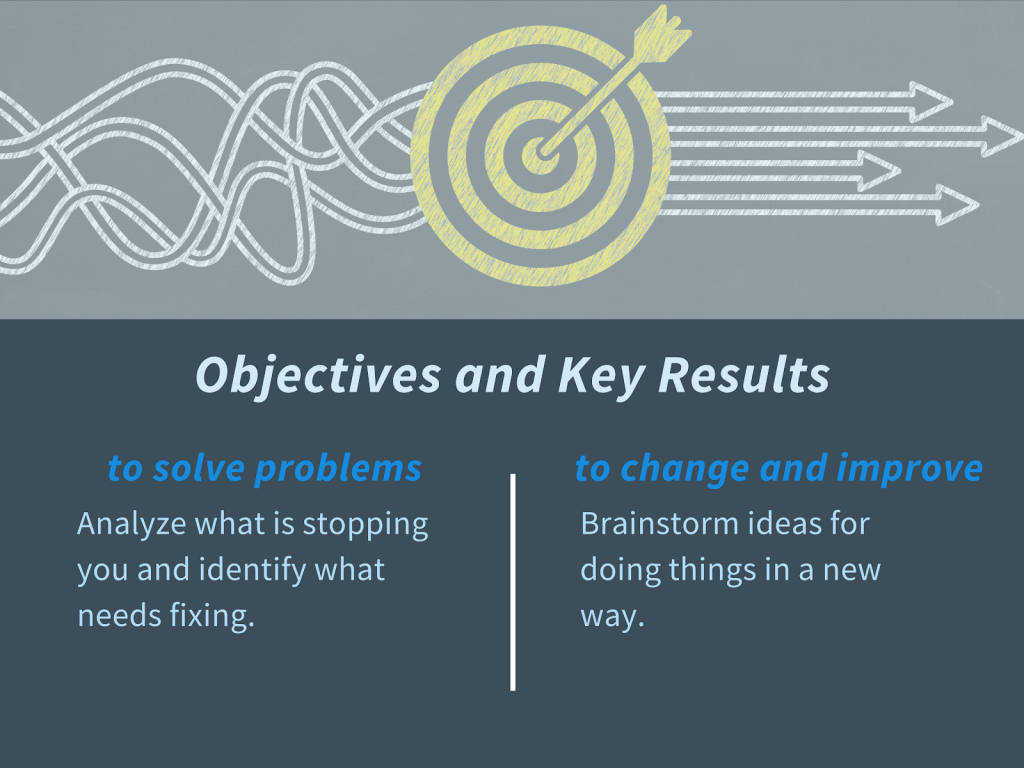
OKR creates intense focus and teaches your team to be result-oriented. The methodology is not for your business-as-usual operations, which means they are not another way to manage everything that you do. Their main purpose is to better your business by singling out improvement areas for the quarter. You can either identify what needs fixing or brainstorm ideas for doing things in a new way.
Start by defining the direction for the whole company, and have teams write OKRs to align with the overarching, company goal. You win by having a clear destination for all teams in your organization. OKRs help you agree on the main focus for the quarter and make sure teams deliver the results that are bringing value for the business.
The world’s most successful organizations set OKRs quarterly. Three months is enough time to deliver valuable outcomes. During this time you will learn what works best and adjust your focus areas for the next quarterly cycle. By reviewing your Objectives and Key Results every 3 months, you have 4 chances per year to respond to the changes in the real world. As opposed to having an annual review and realizing that you’ve been on the wrong path for a year. The world is constantly changing, and so is the market. You have to respond!
2. Accountability & Ownership
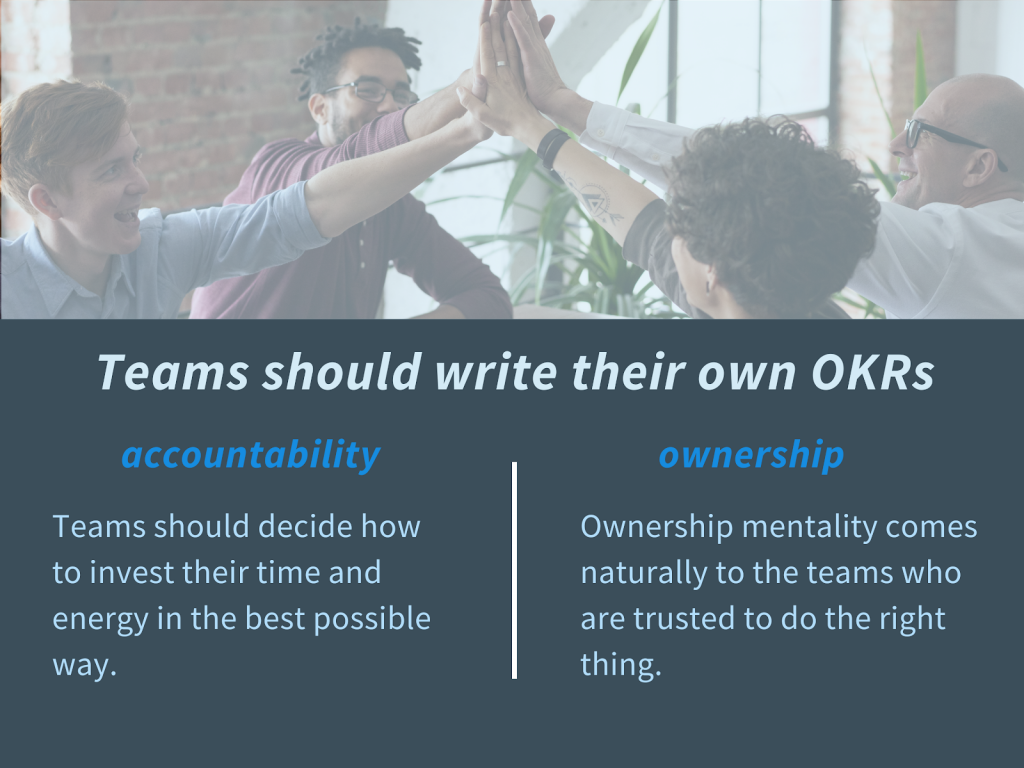
Team OKRs should align with the Company Objectives and contribute to them. This means that the company is creating a unified direction through Objectives, and teams will take ownership of delivering on their OKRs to move the company forward.
Ownership mentality cannot be assigned, it rather comes naturally to the teams who are trusted to do the right thing. That is why, to live up to their potential, teams should be responsible for writing their own collaborative OKRs and deciding on how to invest their time and energy in the best possible way: i.e. what can they fix, change or improve? The OKR framework encourages teams to think about what kind of role they are playing and what they can do to make their contributions more valuable.
3. Shared Understanding of Success
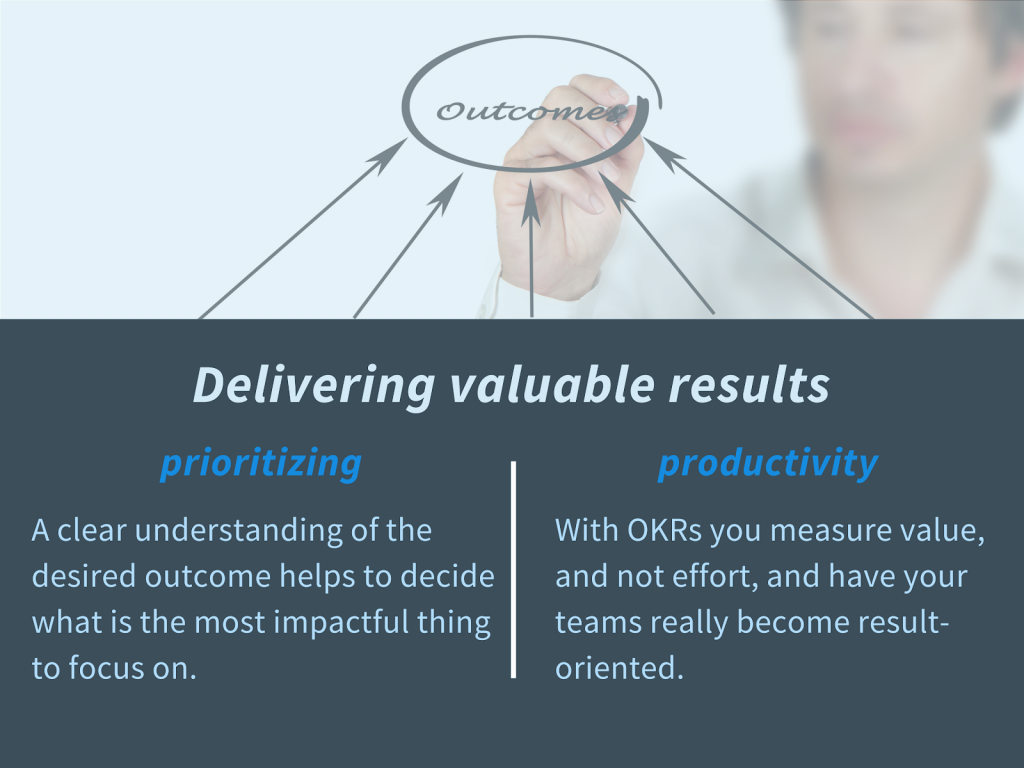
According to the OKR method, an Objective should have 3 to 5 Key Results to define what exactly you want to achieve. So Key Results are measurable outcomes that determine the success of a particular Objective. When the Key Results are clear, the teams then have freedom in deciding which plans are more likely to deliver on the desired outcomes. They can try different approaches and tactics until the Key Results are achieved.
Key Results are not outputs you deliver, they are measurable outcomes that you will strive to achieve. When you are progressing on Key Results, you are getting closer to your Objective.
If you’re completing 50 tasks per day, and nothing changes in your business, you’re not really being productive. What matters is not how many tasks you get done, but what impact they’re having on the Key Results and, ultimately, on the success of the Objective. With OKRs you measure value, and not effort, and have your teams really become result-oriented.
4. Goal Alignment
Alignment is often the very reason why companies want to implement OKRs in the first place. And if the framework is implemented properly, all teams will move in a unified direction.
OKRs make sure your whole company understands what’s important right now. It sounds quite simple, but in reality, it’s all too common for teams to work on their own things in silos, use valuable resources (like time and money), and pull the company in different directions. If you’re not rowing in the same direction, you’re either moving slowly or not moving at all.
That doesn’t mean that all teams should have exactly the same shared OKR. What it actually means is that teams would be approaching a bigger overarching Objective from a team-specific perspective, function, and expertise.
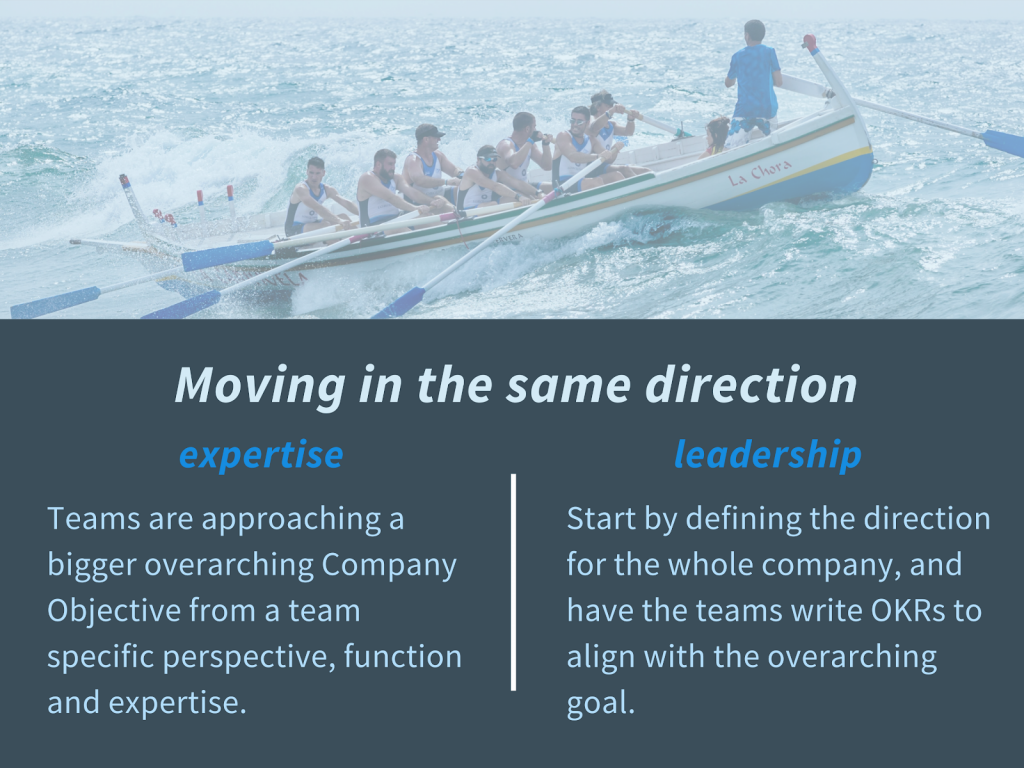
Company Objectives are the north-stars, and the Team OKRs should be linked up to the company level. The overarching Company Objectives will move forward as teams get closer to their Objectives, as measured by the Key Results.
For example, let’s imagine that a company has been falling behind with their revenue lately. The company might want to set an Objective “Get revenue back on track” and communicate to the teams that this is the top priority.
But this is a lazy Objective as it is not specific enough. Why are you falling behind? What can you change right now to see an impact on your revenue numbers? Is it something your competitors are doing or was there a change in market conditions?
Or, perhaps, you are taking too much time processing orders of your customers and not delivering on time. So now with bad reviews on the internet, new potential customers don’t trust you and older customers are not coming back. That is why revenue is dropping. In this case, the Company Objective could be to “Increase order processing time and ensure customer satisfaction“. Each team then approaches this goal from their different angles thinking about what they can improve and contribute to.
There are several issues that could be addressed by the teams in this example: Automate order processing to reduce the time per transaction (Sales team), Improve customer reviews posted online (Marketing), Improve the quality of online communication (Customer Support), Improve usability of online ordering system (Product Development), etc.
There are always many things for teams to do, but if they are not working towards the same company goals, they are most probably slowing down the entire organization. Alignment (if done right) has strong implications for growth and efficiency.
14 day company trial for unlimited users. Invite your teams today
5. Transparency
To align the teams and have everyone move in the same direction you need to allow transparency throughout the entire organization. Ideas and pieces of information, like pieces of a puzzle, need to connect to produce a bigger picture.
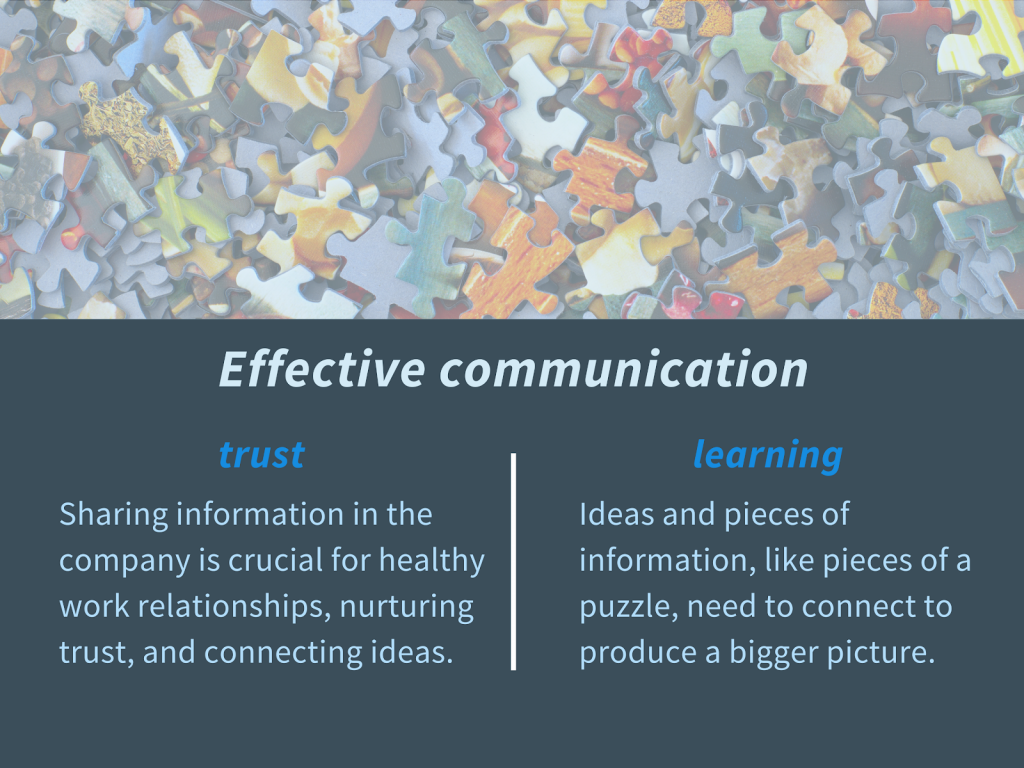
This is not about sharing high-level financial targets; transparency comes from meaningful discussions led by the OKR process. It begins with communicating Company Objectives for the quarter with context and background information. What problems are we facing? What areas should we improve? What’s stopping us? Encouraging everyone to share ideas and participate in these discussions creates an environment for effective communication among teams and individuals.
Sharing information and key learnings in the company (either in meetings or in organized digital workspaces) is crucial for healthy work relationships, nurturing trust, and connecting ideas. It’s definitely worth doing because transparency leads to effective communication and improved productivity.
By using an OKR software like Weekdone, you effortlessly allow full visibility of OKRs, Weekly Check-ins (Plans, Progress, and Problems), comments, and updates related to them. They are clearly structured and easy to access.
Here’s what you get with full visibility and easy access to quarterly OKRs and Weekly Plans:
- It saves teams time in meetings so they can focus on execution. Team discussions should be about getting organized and keeping track of their progress: what’s working, what’s not. Everything else people can read in the company’s newsfeed.
- Business processes run faster. Since people know what’s going on in the company’s life, it’s much easier to maintain a sense of urgency for Company Objectives.
- It boosts engagement and fuels accountability. When a team’s priorities and achievements are seen by others, there’s no place for excuses or just pretending to be busy. There’s also no place for procrastination. And, more importantly, when they get it done, others can see how valuable their work is, and they feel appreciated. Motivated teams who take ownership of their OKRs is the dream of every leader.
14 day company trial for unlimited users. Invite your teams today
6. Growth, Improvement & Innovation
Companies use OKRs to drive growth through improvement and innovation. This means OKRs are not a list of everything you do in your business. Business-as-usual operations are your regular day-to-day work, and OKRs focus on change: either in what you’re doing or how you’re doing it.
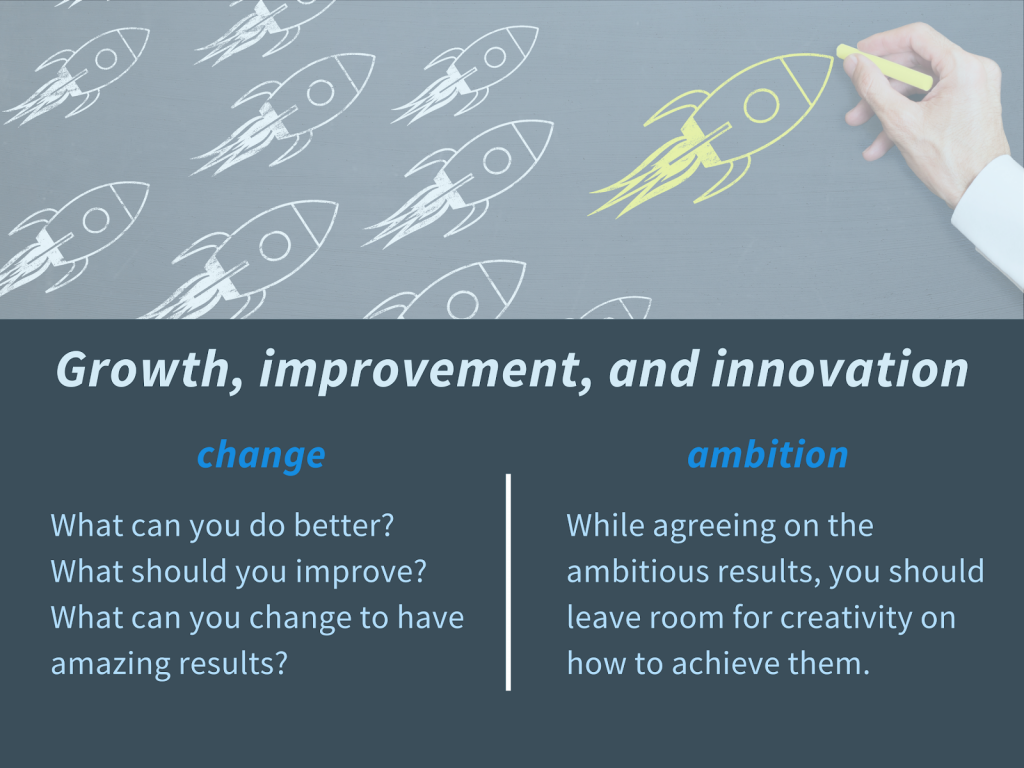
Working with OKRs means that all teams need to think about what they can contribute to achieving Company Objectives. What can they do better? What should they improve? Is there something they are doing great and can they raise the bar and bring even better results?
These questions start meaningful conversations in your teams and your company would benefit greatly from knowing the answers. To get incredible results you need a goal-setting methodology that leads you to think outside of the box. While agreeing on the ambitious results (measurable outcomes), you leave a lot of room for creativity on how to achieve them. Versus, if you just tell people what to do (outputs) and might be completely wrong about what works and what doesn’t.
Enjoy the Benefits of the OKR Methodology in your Company
OKRs put great emphasis on effective teamwork, alignment, and accountability which is achieved through focusing the entire team on working smarter, not harder.
When you work hard, you cross 50 items off your list, and nothing changes in your business. Working smart, however, means figuring out high-level priorities, defining measurable outcomes that you want to achieve, and taking immediate massive action.
The benefits of OKRs are not circumstantial or accidental. You can enjoy them fully only if you are being intentional in your goal-setting process and follow the main principles and guidelines.
Learn more about OKRs and how to implement them in your company with our free Guide to OKRs.